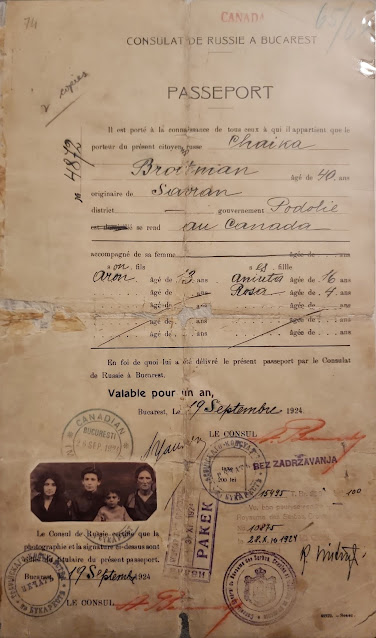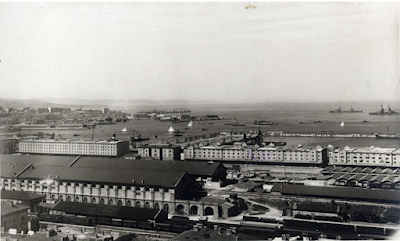2024 - 2023 - 2022 - 2021 - 2020 - 2019 - 2018
Wednesday, December 25, 2024
Happy New Year 2025!
2024 - 2023 - 2022 - 2021 - 2020 - 2019 - 2018
The Broitman Family Reunited
Introduction
Chaika Broitman and her three children were racing against time to leave Romania. Chaika’s husband Abram had make it to Canada in July 1924, successfully rescued from Europe by a Canadian refugee resettlement program. Unfortunately, that program was already experiencing problems in the summer of 1924, and in October new limitations were enacted that all but barred Russian Jewish refugees from entering Canada.
According to a letter from JDC Acting Chairman Dr. B. Kahn to his American colleagues, dated July 30, 1924 , conditions in Romania were getting increasingly desperate. Two thousand and sixty refugees remained in Bucharest, with 80% of them already having been stuck there for three or four years. This was likely true of the Broitmans, who had spent time in both Kishinev and Bucharest. Dr. Kahn further noted that one-third of the refugees were “…beggers, cripples, insane people, people who are unfit of the work, [and] deserted wives.” He bemoaned the limitations of the Canadian refugee program, and accused the ICA of only supporting those refugees with the financial wherewithal to defray some of the costs of their travel. He concluded his letter by saying, “we are unable to tell what will happen to [the refugees] after [November 1, 2024].”
The Broitmans were fortunate: they were selected to leave that November on what would be the program’s very last transport of Russian Jewish refugees out of Romania. Had they not left then, it is not clear what would have happened to them.
 |
| Front of the 1924 Passport of Chaika Broitman and her three children. |
A Story in Stamps
When Rose Broitman Telles moved out of her home in New Jersey and into a nursing facility around 2002, I was the one who went through the papers in the cabinet in her guest room. Among the treasures I found was an enigmatic passport dated 1924, with Chaika’s name and the names of the three children. With information in both French and Russian, I had no idea at the time what stories it would tell. Professor Rodica Botoman at The Ohio State University kindly helped me understand the meaning of the various stamps. Understanding the importance of the document, I had it professionally preserved, deacidifying the paper and removing any adhesive tape.
The passport includes the vital information in French (shown) and in Russian on a second page. It was issued by the Russian consulate in Bucharest; but it is important to remember that there was actually no country called “Russia” at the time. The Soviet Union had been established, but Romania had not yet recognized that government. In the meantime, representatives of the previous government remained at what had been the Russian consulate to manage any state property and to help displaced Russian citizens.
A single passport was issued on September 19, 1924, to Chaika and her three minor children. Boys were listed on the left side, and girls on the right. Rose’s age is listed as four, but according to family stories, she was actually five or six. She was small for her age, probably due to years of malnutrition. The passport lists Chaika’s last place of residence in Russia as Savran in Podolia.
The administrative hurdles that would allow Chaika and her children to leave Romania for Canada were daunting. Permission for travel required the approval of Russian, Romanian, and Canadian officials, plus visas from any country through which the refugees would pass. Undoubtedly, these approvals were facilitated by representatives of ICA, JDC, and HIAS in Romania. The refugees travelled as a group of 500, by train, and the route they took was part of the famed Orient Express.
By the time Chaika reached Halifax weeks later, her family passport included sixteen stamps in seven languages. The passport tells the story of their journey.
 |
| Advertisement for the Simplon Orient Express. The route taken by the refugees, which followed one of the routes of the Orient Express, was the most direct train route from Bucharest to Trieste at the time. |
|
Passport |
Language |
Location |
Date |
Translation/Meaning |
|
|
N/A |
Bucharest Romania |
Sept. 1924 |
This haunting photo of Chaika and her children is the oldest photo we
have of the family. They are all wearing simple clothing. Chaika, who was
described as full-figured when she was older, looks absolutely gaunt. There are no signs of a stamp because this was not the original
passport photo, though it was found with the passport in 2002. The original photo must have fallen off
decades earlier. |
|
|
Russian |
Bucharest Romania |
Sept. 19,
1924 |
These stamps from the Russian consulate confirm the authenticity of
the (original) photo, the signatures, and the 200 lei payment (worth approximately $1 USD in
1924). |
|
English |
Bucharest Romania |
Sept. 26,
1924 |
A week after obtaining their passport, the Broitmans received
approval from the Canadian consulate allowing entry into Canada. |
|
|
|
English |
Bucharest Romania |
Sept. 26,
1924 |
This stamp is located on the back of the passport. According to a
representative from the Pier21 Canadian Immigration Museum, “…this
handwritten completion of a stamp appears to be for a (successful) overseas
inspection on 26 September 1924. The timing and potential to be assigned a
"category" suggests that this is the stamp for the overseas
medical examination. The signature is likely that of an authorized doctor
overseas.” The barely legible third line might read “Port: Bucharest.” |
|
|
French |
Bucharest Romania |
Oct. 28, 1924 |
To get from Bucharest to the port in Trieste, the Broitmans would need to travel through the “Kingdom of Serbs, Croats, and Slovenes.” This country, which was formed in the aftermath of WWI, would be renamed Yugoslavia in 1929. Nearly a month after getting their stamp from the Canadian government, Chaika received approval to pass through the Kingdom of Serbs, Croats, and Slovenes en route to Italy. The family wasted no time leaving Bucharest, their home for the past
several years. They rushed to the border, covering almost 400 miles in the
next 72 hours. |
|
|
Romanian |
Jimbolia Romania |
Oct. 31, 1924 |
This stamp indicates the departure of the Broitmans from Romanian
territory. The town name isn’t completely clear, but based on their entry
point into the future Yugoslavia, they must have crossed the border at
Jimbolia -- almost 400 miles from Bucharest. |
|
Serbian |
Kikinda
(Кикинда) Kingdom of Serbs, Croats, and Slovenes (now Serbia) |
Nov. 1, 1924 |
This stamp indicates their entry into the Kingdom of Serbs, Croats, and Slovenes (Краљевина Срба, Хрвата и Словенаца). The entry point was Kikinda in modern-day Serbia, right on the border with Romania and less than 15 miles from Jimbolia. |
|
|
|
Serbian |
Rakek
(Ракек) Kingdom of Serbs, Croats, and Slovenes (now
Slovenia) |
Nov. 3, 1924 |
Two days after entering the Kingdom of Serbs, Croats, and Slovenes at
Kikinda, the family crossed the border into Italy at what is now Rakek,
Slovenia. The journey from Kikinda to Rakek was another 400 miles. |
|
|
Bosnian/
Croatian |
Unknown |
Unknown |
This stamp means “no holding back,” presumably indicating that the
family passed inspection. It is unclear if this occurred when they received
their visa; upon entry into the Kingdom of Serbs, Croats, and Slovenes; or
days later, somewhere in the interior of the country. |
|
Italian |
Postumia Italy (now
Slovenia) |
Nov. 3, 1924 |
Rakek is only seven miles from Postumia, which in 1924 was part of
Italy. Postumia is 30 miles from Trieste. |
|
|
Italian |
Trieste Italy |
Nov. 5, 1924 |
Two days after arriving in Italy, the Broitmans left for Canada at
the Port of Trieste. They had traveled more than 850 miles in 4-5 days. The overland portion of their journey was complete. |
The Port of Trieste
 |
| Undated photo of the port of Trieste. |
The Broitmans stayed in the Italian port city of Trieste for only a few days, and little is known about their time there. They were likely confined to a boarding house to ensure they continued to their destination. A committee supporting the Jewish migrants and refugees had been established in Trieste after WWI. Called the “Comitato di assistenza per gli emigrati ebrei,” it was in operation until 1943. Perhaps they helped the Broitman family and their fellow refugees.
 |
| Plaque commemorating the work of the "Comitato di assistenza per gli emigrati ebrei" (Committee for the Assistance of Jewish Emigrants) in Trieste. The text reads: "The Italian committee for assistance to Jewish emigrants had its headquarters and operated here from 1921 to 1943. They organized the aliyah [calling up] to Israel of the Jews from Central and Eastern Europe. In this building they found hospitality and rest while waiting for the embarkation to the promised land. Trieste deserves the name of "Gate of Zion." Posted on the 50th anniversary of the foundation of the State of Israel." Photo courtesy of Professor Aleksej Kalc of the Slovenian Migration Institute. |
The SS Presidente Wilson and Family Stories Confirmed
 |
| Undated postcard of the Presidente Wilson. "T.S.S." indicates "Turbine Steam Ship" |
My grandmother, Rose Broitman Telles, told me stories about her voyage on the ship. Only five or six years old or so at the time, she remembered sneaking out of steerage into first class to collect oranges for her pregnant mother. Another story she told was of a giant wave hitting the ship in the middle of the night, causing 13-year-old brother Aron to fall out of his bunk. An archivist in Halifax kindly shared newspaper account confirming that the SS Presidente Wilson was in fact hit by a rogue wave.
Arrival
On November 20, 1924, almost a month after leaving Bucharest, Chaika and her family made it to Halifax. Their processing there was likely similar to that of Abram just a few months earlier.
Stamps on the back of their passport tell of the next part of their journey.
|
Language |
Location |
Date |
Translation/Meaning |
|
|
|
English |
Halifax, Nova
Scotia, Canada |
Nov. 20, 1924 |
This stamp indicates
arrival into Canada, and overlaps with the health inspection stamp made two
months previously. According to representatives from the Canadian Museum of Immigration at Pier21, GLM likely corresponded
to the inspecting officer. |
|
|
English |
Halifax, Nova
Scotia, Canada |
|
The
"authority for admission" file indicates an administrative file related
to admission. This was likely created in response to correspondence between
the settlement agency (JCA) and the immigration branch (Ottawa) to assist a
group of immigrants in entering the country. |
Having jumped through all the immigration hoops, Chaika and her family boarded a train to Toronto, where she was reunited with Abram. They hadn’t seen each other in almost five months. Abram’s address on the “Report of the distribution of the Twelfth group of 511 refugees was listed as 29 Kensington Avenue. Two months after reaching Canada, on January 25, 1925, Chaika gave birth to their son Joseph. After five years and nearly 6,500 miles, the Broitmans’ long journey from the horrors of the revolutionary pogroms to the safety of the West was over.
Next…new beginnings.
 |
| Interwar map of Europe with Yiddish place names. The path taken by the Broitman family is indicated in red. |
 |
| Record of the Broitman family's arrival in the Canadian Jewish Archives |





















